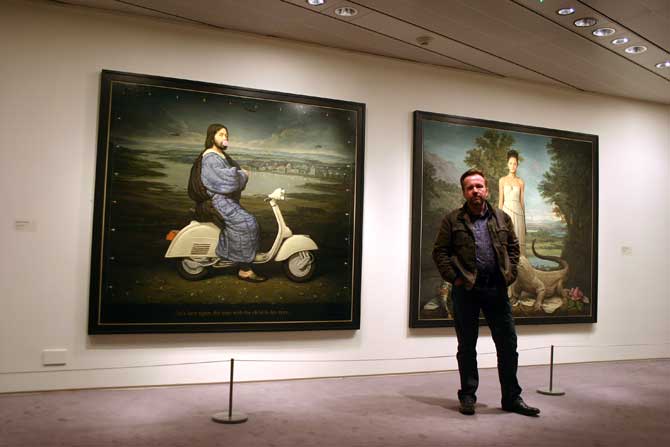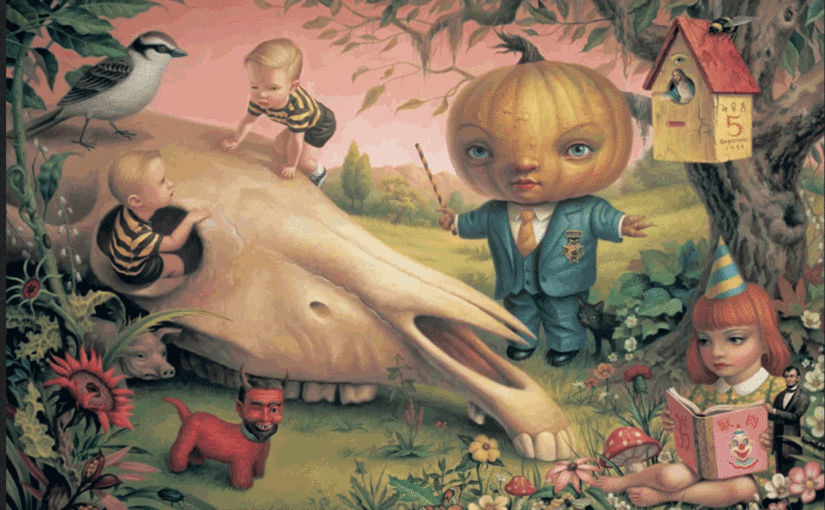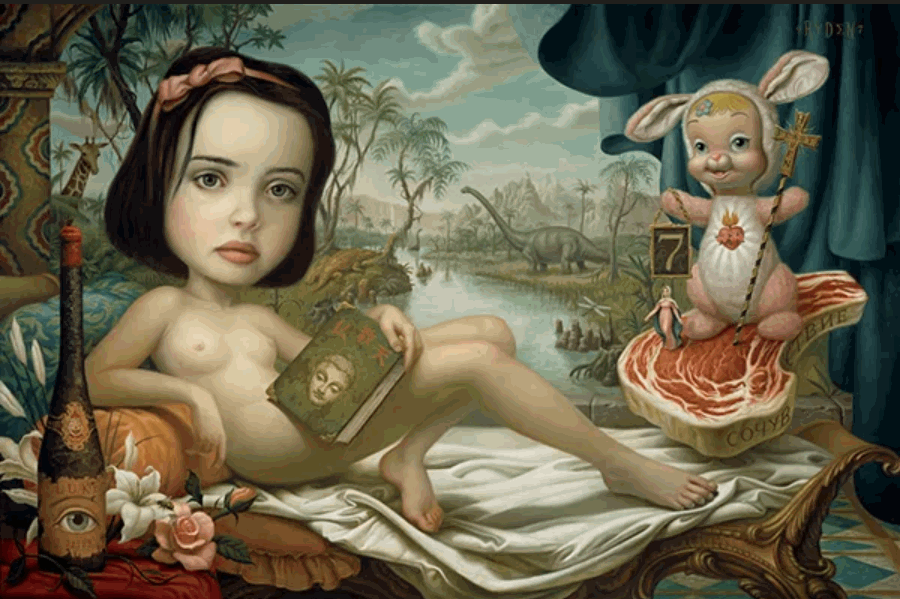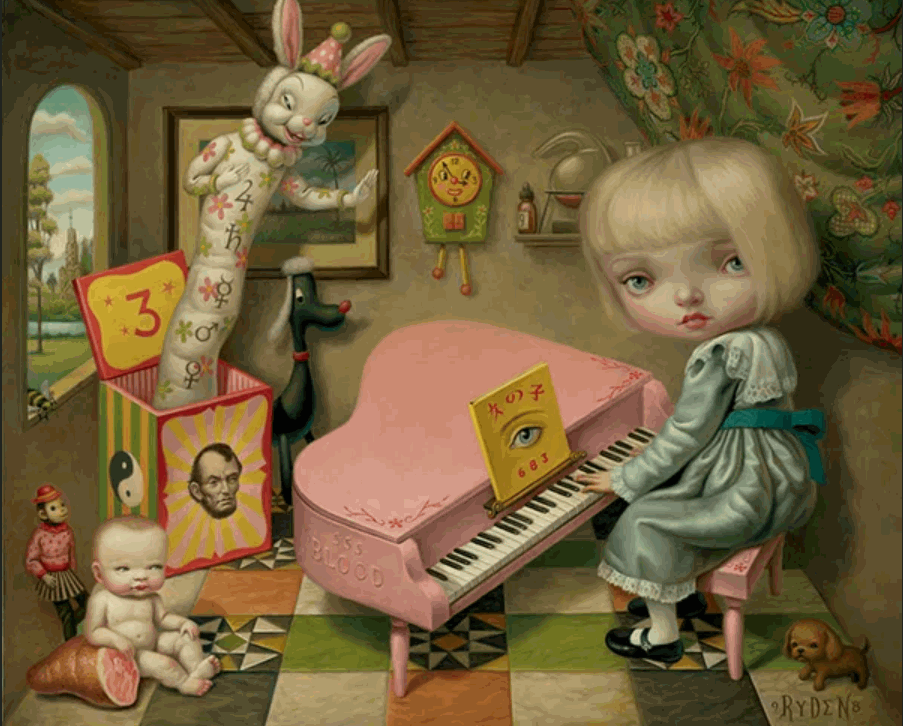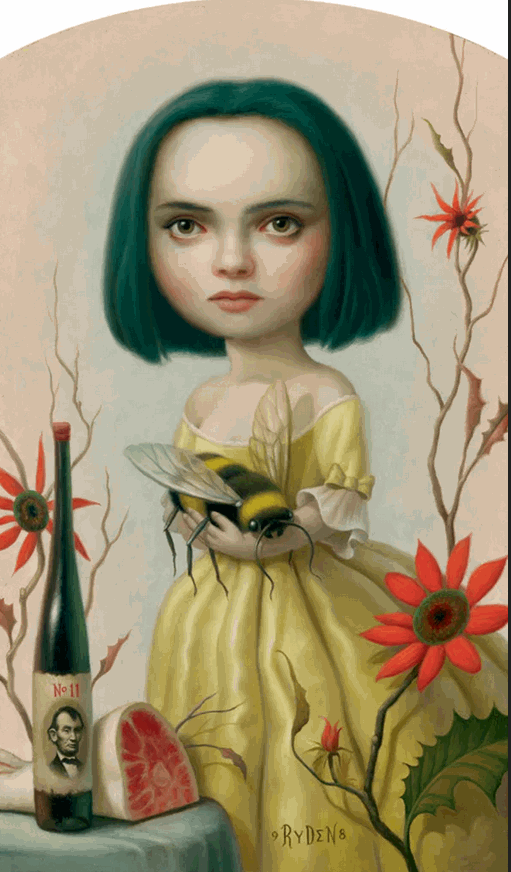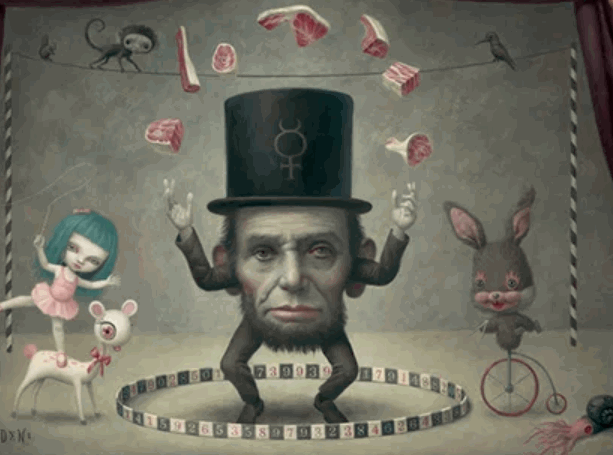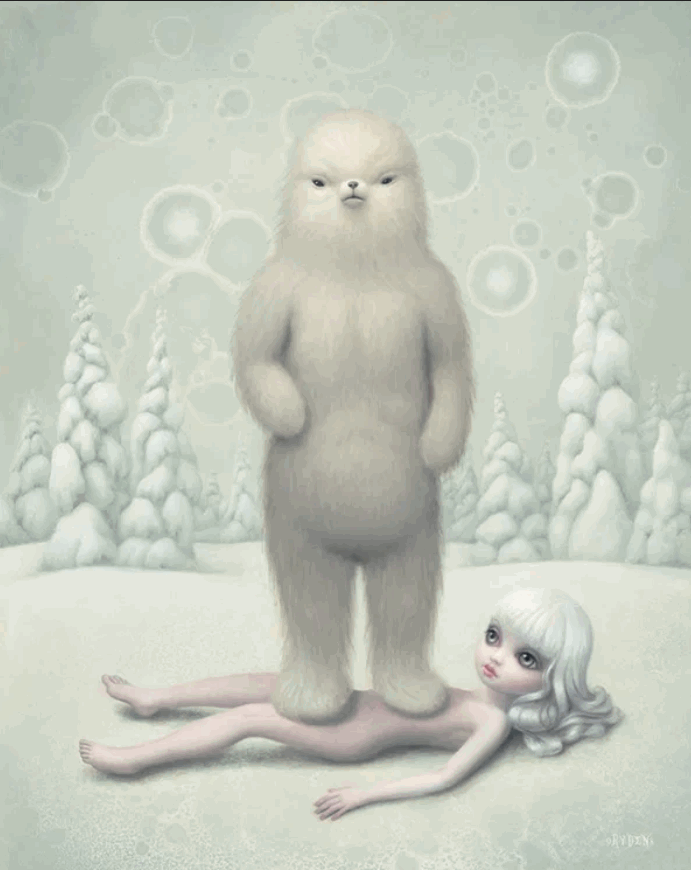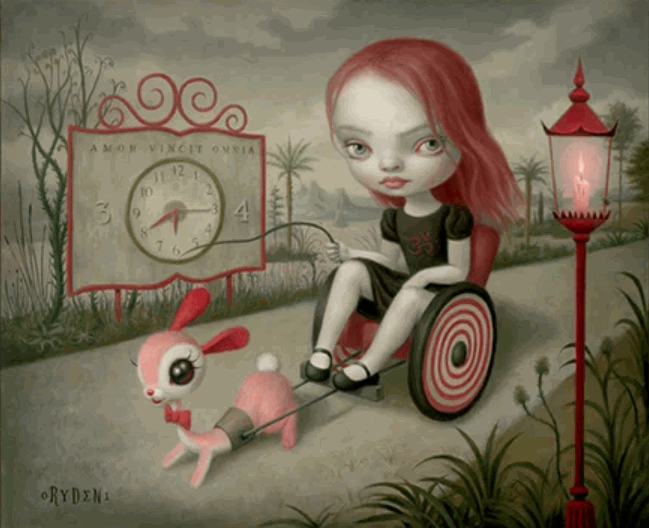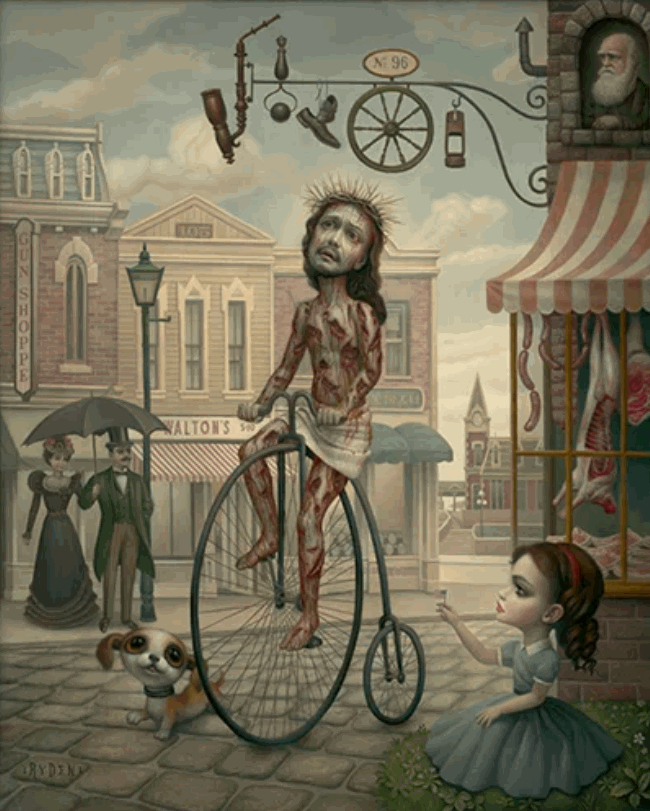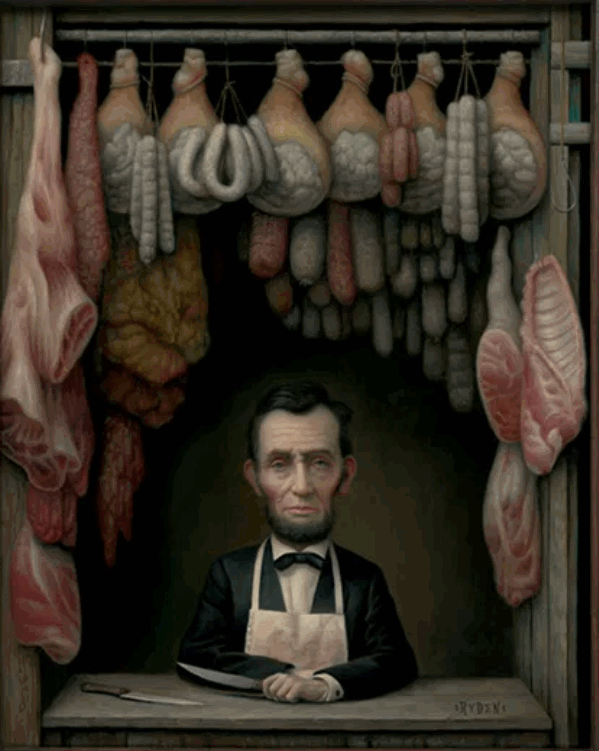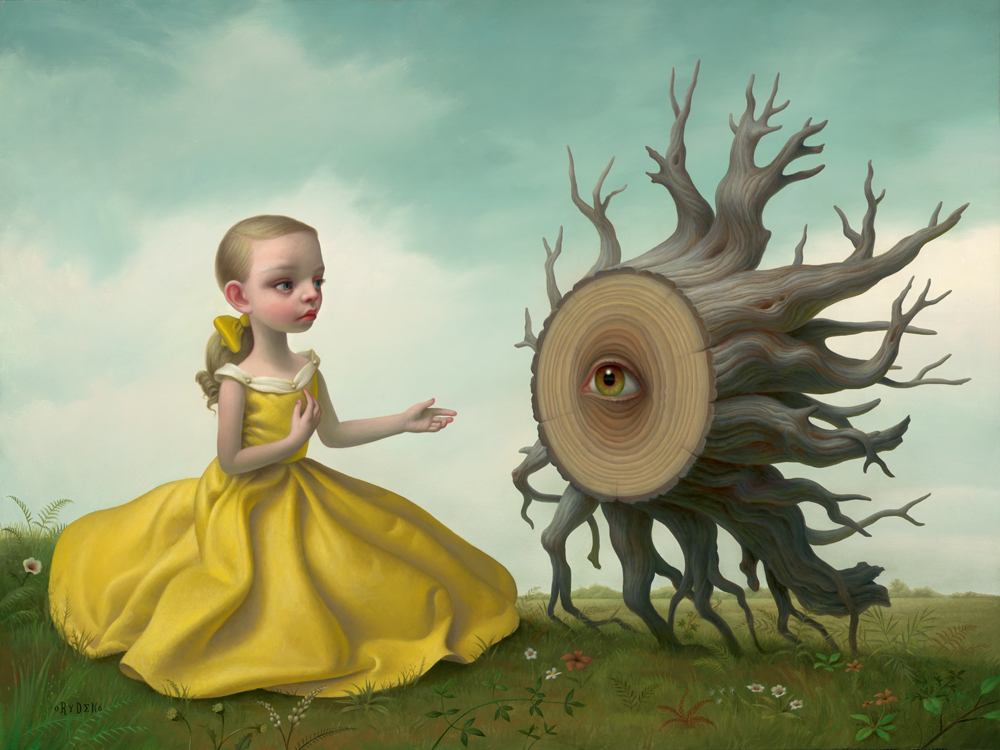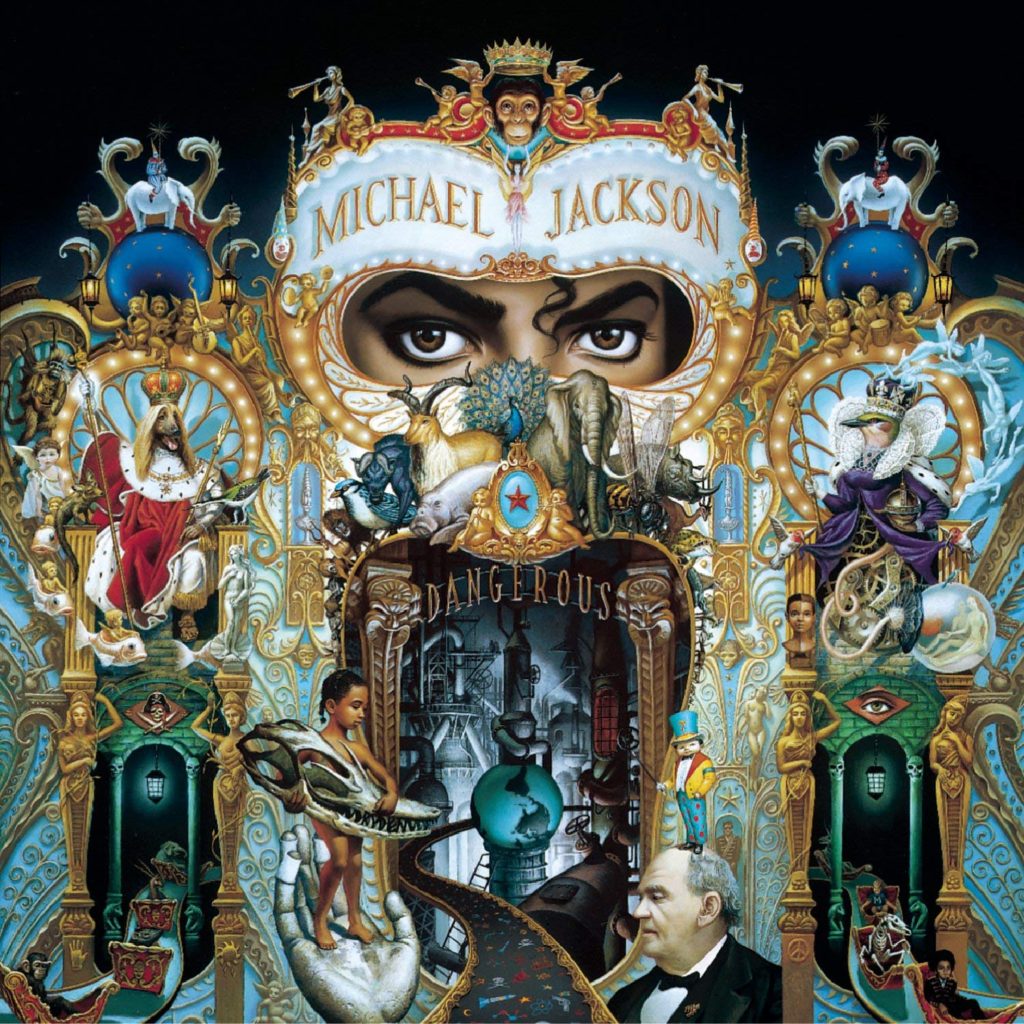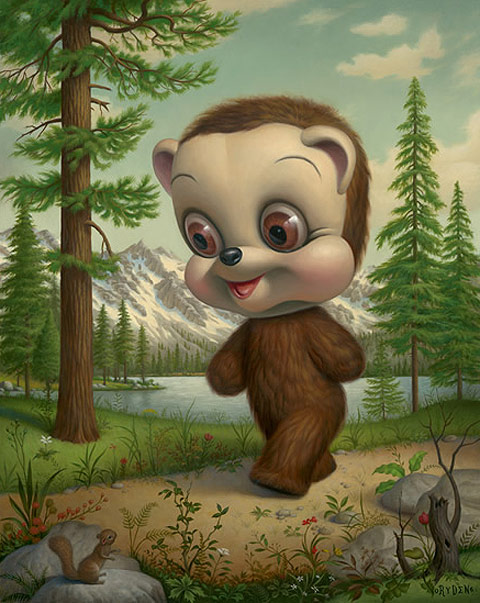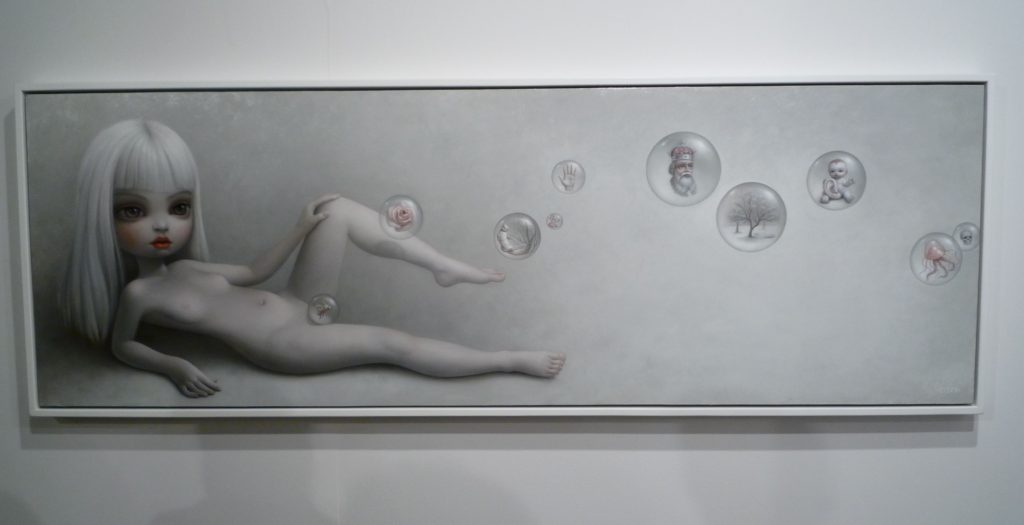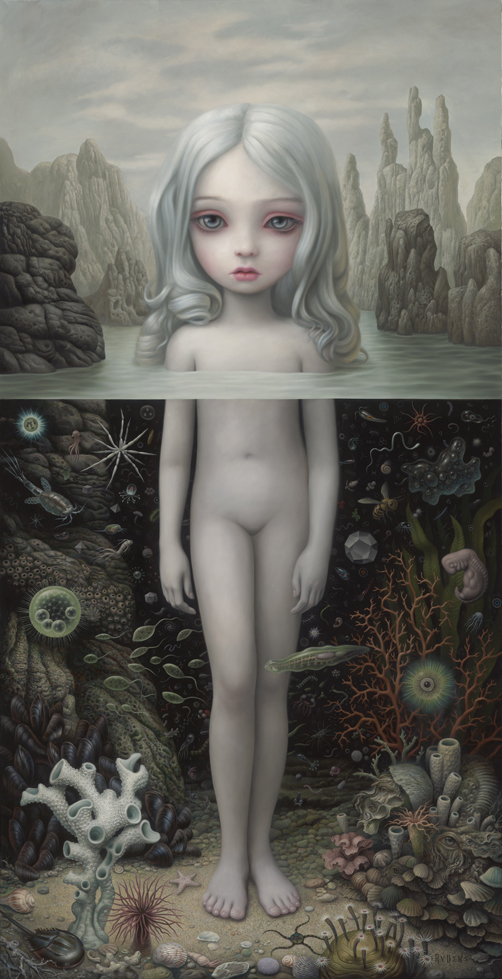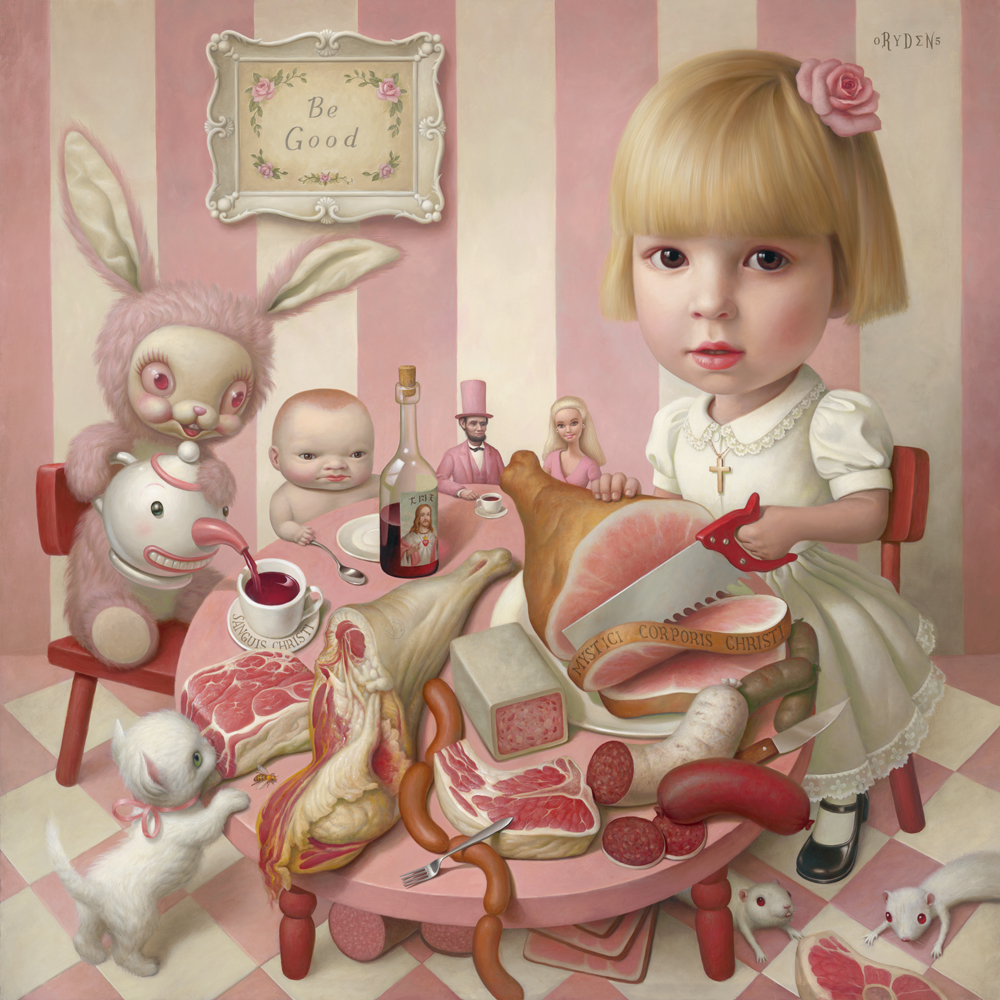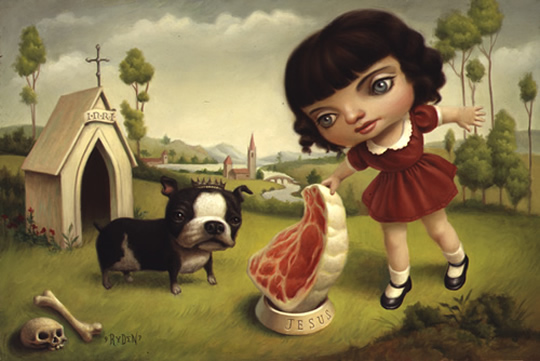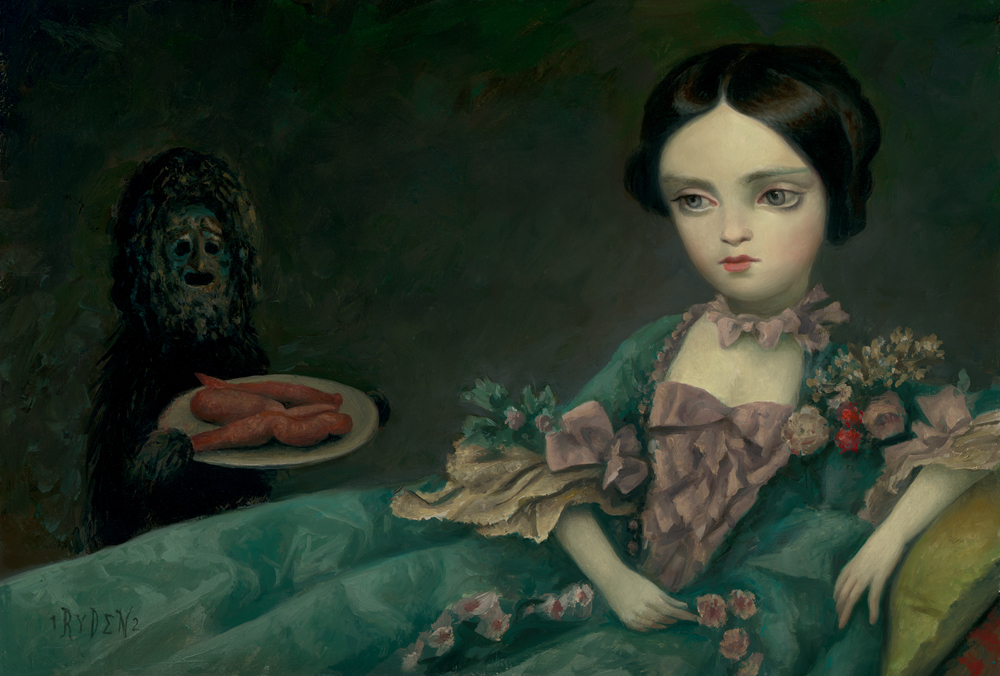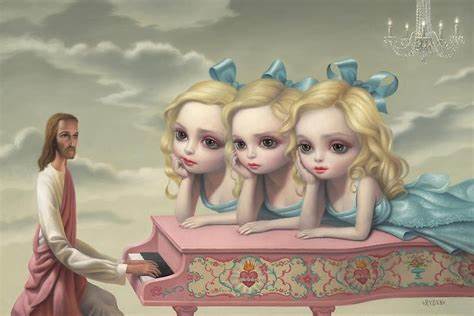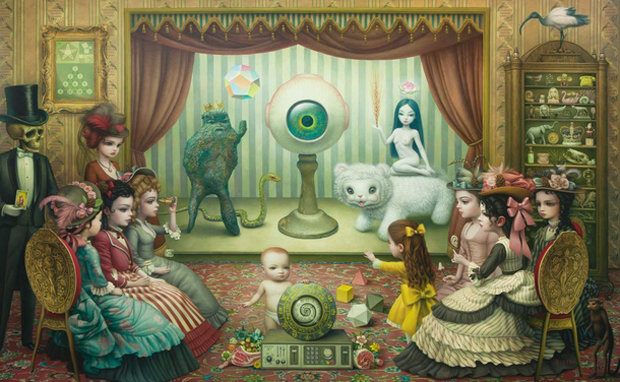There is a cool, quiet elegance to Alan Macdonald’s paintings, which belies the disequilibrium at their heart. His figures, grey eyed and dreaming, might be time travellers, drawing distant cousinship from the portraits of Rembrandt or Frans Hals. His bucolic northern landscapes lay claim to an equally venerable artistic heritage. But if an accretion of the art historical past informs his imagery, it is transposed into a world where confidence has been lost, where the spiritual beliefs and myths which once bound man to nature, and through nature, to the divine, fail to connect.
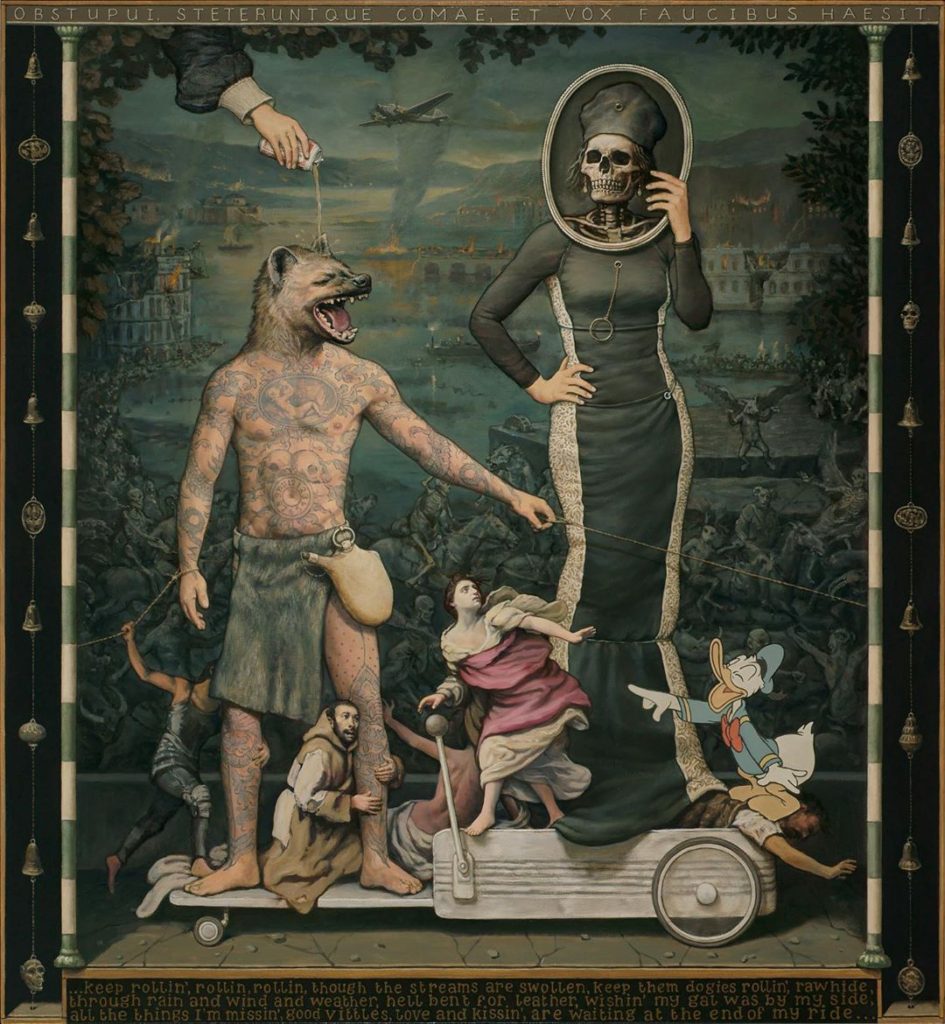
Frequently, single letters or words, even meticulously copied dictionary definitions, are added to the sections of a painting, as if language might hold a key.
We follow through the a,b,c, trying to piece together the jigsaw, but language proves as fallible as any system by which we structure our existence, and we are left with a series of miswired lexical circuits. Is a landscape “an area of land regarded as being visually distinct,” or is it “a painting, drawing, photograph etc. depicting natural scenery?”
Macdonald lets both definitions stand. Though he would not call himself a surrealist, like Magritte, he points up the ambiguities surrounding real objects and their images in art, encouraging us to consider his work as more than a simple pictorial narrative.
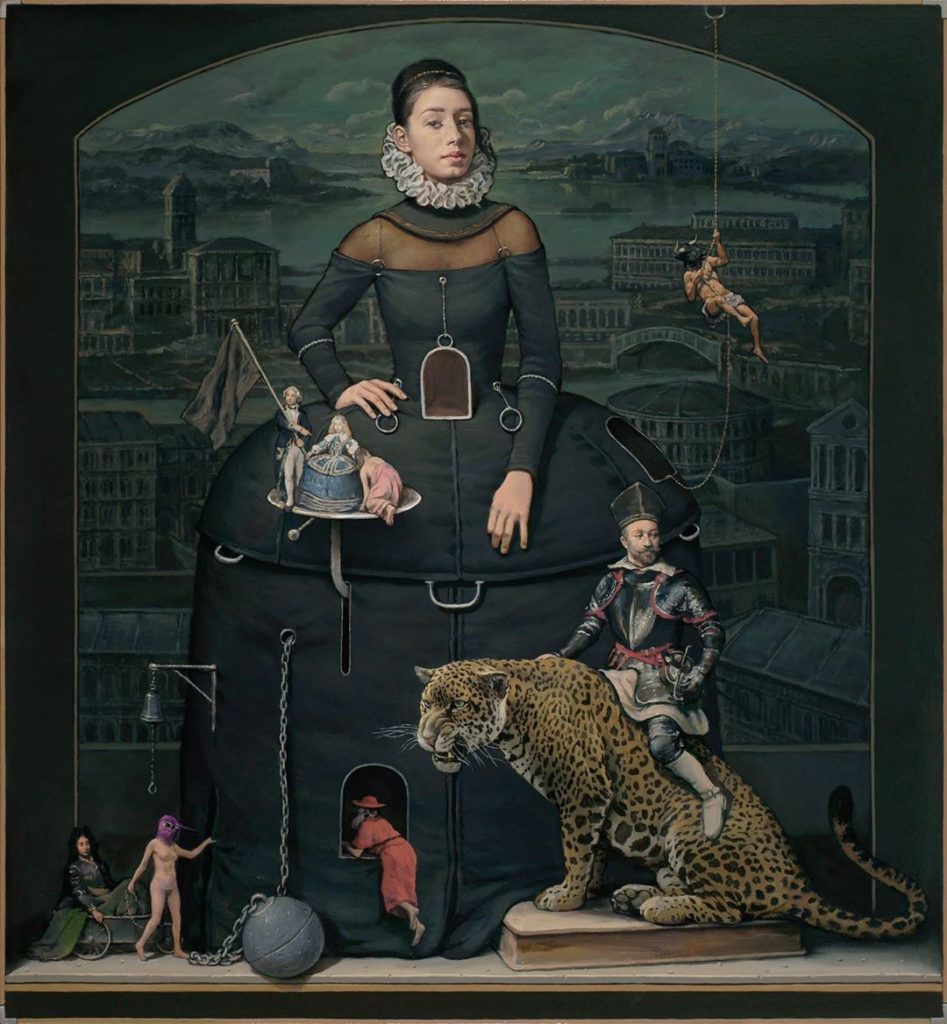
The otherworldly characters in his series of portrait heads have the look of forgotten pilgrims, bonneted and constrained by cords like the followers of some perverse form of Puritanism. Each is neatly titled according to a state of mind: hedonist, altruist, sadist. We read the titles and search their waxen features, hoping to discover their soul in the curl of a lip, or the tilt of a chin. Despite this attempt at self assertion the figures remain isolated, pinned down by their cords, as if by the codes and strictures of society.
These are beautiful paintings, all the more potent for their distilled sense of calm. Macdonald gives us no answers, but the questions he raises about the search for faith and identity in a difficult modern world touch a nerve, and in the faces of his pilgrims, we recognise ourselves.
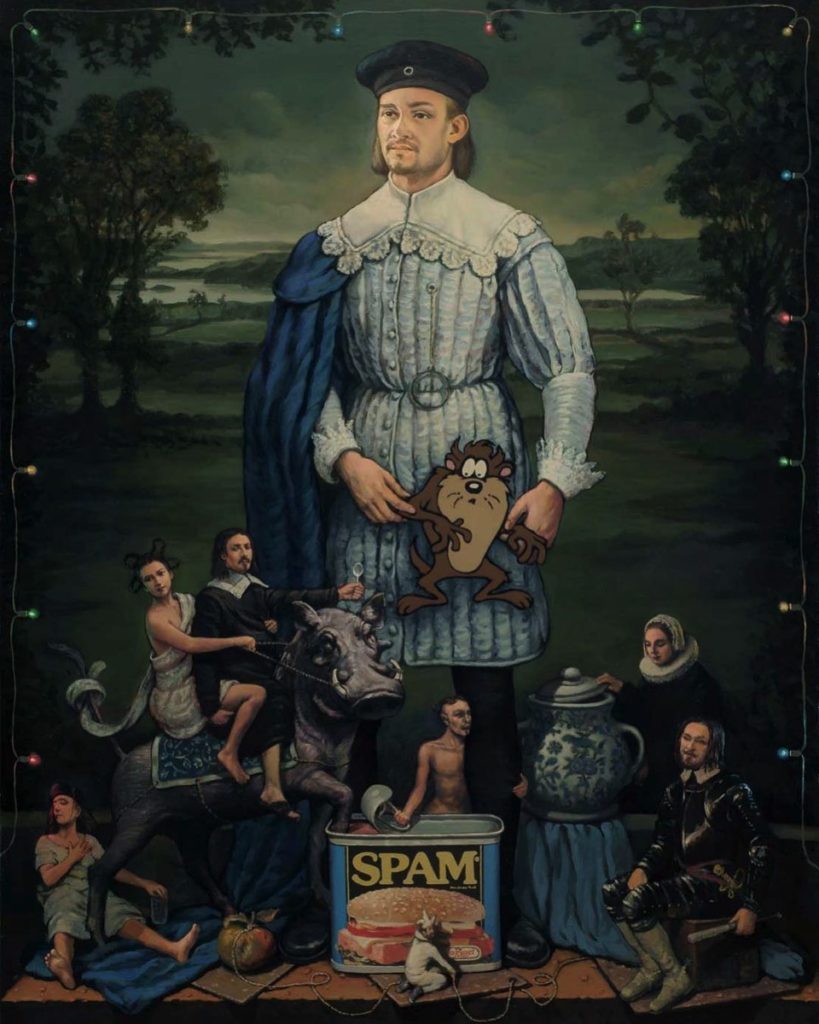
It seems fitting that artist Alan Macdonald, born and brought up in Malawi, one of the least populated areas in South East Africa, now lives and works in a small town not too far from medieval Edinburgh, Scotland. His meticulously crafted images are emblematic of Scottish characteristics – love of nature, history, humour, beauty and surreal scenery – linked together in compelling enigmatic and sometimes foreign imagery.
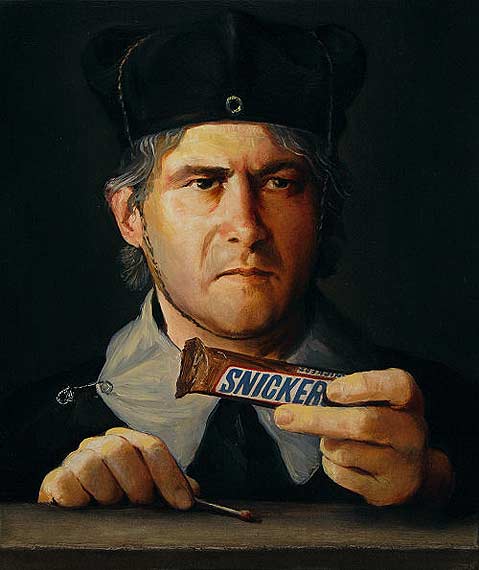
" “It took me years to realize that it is the darkness in things that I respond to, whether it is a painting by Francisco Goya, a song by Leonard Cohen, a play by William Shakespeare or a film by Pedro Almodovar. When I was a child living in Africa, I was outside on a night lit by the moon and, feeling a little scared, I stepped from the light into a dark shadow,” the artist told Tatha Gallery. “The darkness wrapped itself around me and fear was replaced by an understanding that I was being protected. Later, when I was twelve, a boy walked into my classroom with drawings he had done in pencil. They were representations of figures, that went from the white of the paper to the blackest black that the graphite could muster, and from that moment the artistic light for me was ignited.” -Alan MacDonald
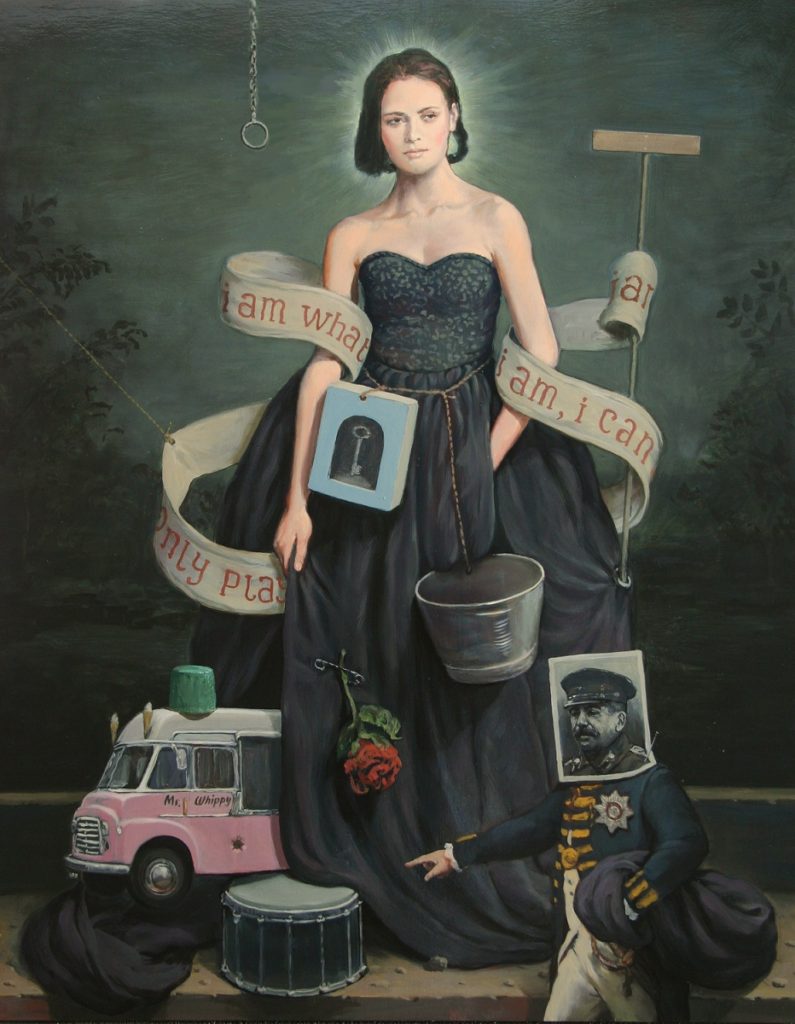
There is seemingly no element too exotic to inhabit an oil painting by Alan MacDonald, whose works traverse cultures and histories to present something always elegant in execution. At the base of MacDonald’s work seems to be a need for adventure, exploring inspiration and varying perspectives in each work.
- Alan Macdonald Paintings
- The Oil Paintings of Alan MacDonald | Hi-Fructose Magazine
- Alan Macdonald – Art, Bio, Insights – Artsy
- Alan Macdonald – Home | Facebook
- Alan Macdonald | Tatha Gallery | Scottish Art Gallery
- Alan Macdonald | Art Auction Results
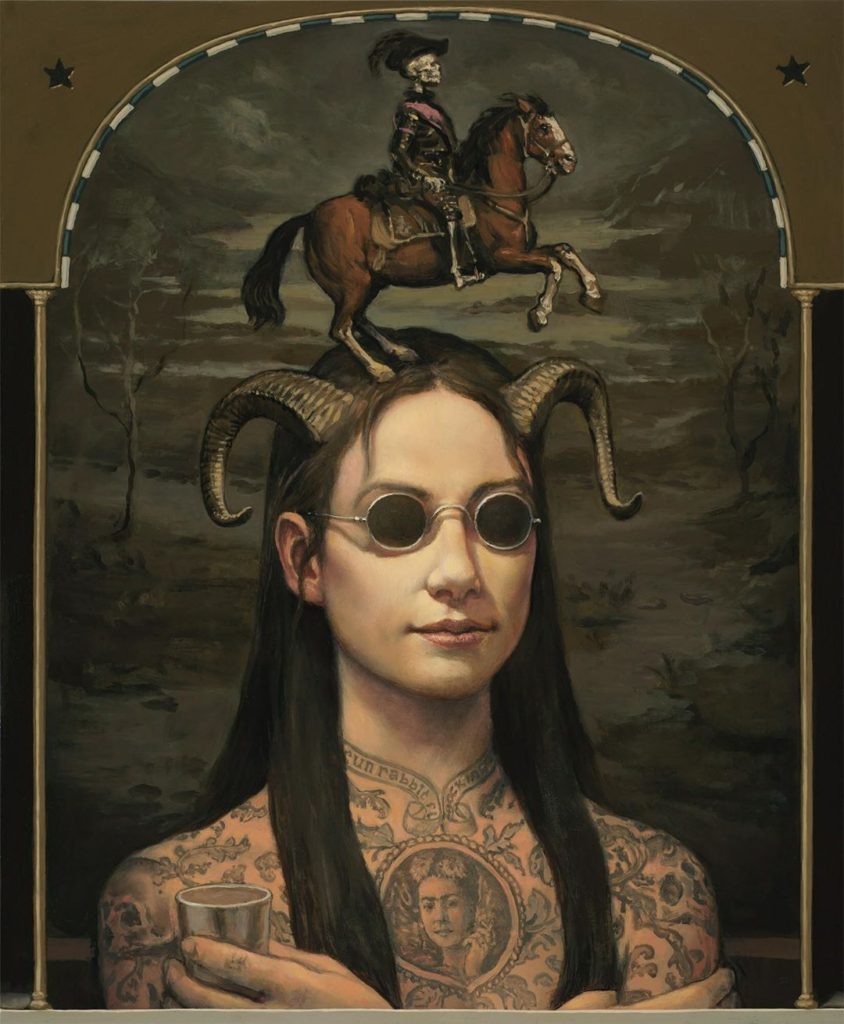
Exhibiting in the United States and Holland, Dundee-trained Alan Macdonald has clearly distilled his own unique visual language in an impressive debut at Kilmorack. This is sophisticated, visually literate work both in terms of technical execution and multi-layered exploration of ideas, infused with humour and defined with precision.
While there are many art historical influences to be seen in this work, Macdonald remains his own man, in full knowledge of the canon, playfully seducing the viewer with familiarity of style then subverting expectation of traditional narrative. Displacement of elements; the surreal juxtaposition of classical and industrial architecture, the adornment and status of costume with utilitarian functionality and the presence of consumer branding/ Pop elements in the same frame as traditions of historical painting and portraiture thankfully never allow the audience to get too comfortable.
-Statements by Alan MacDonald © Georgina Coburn, 2011
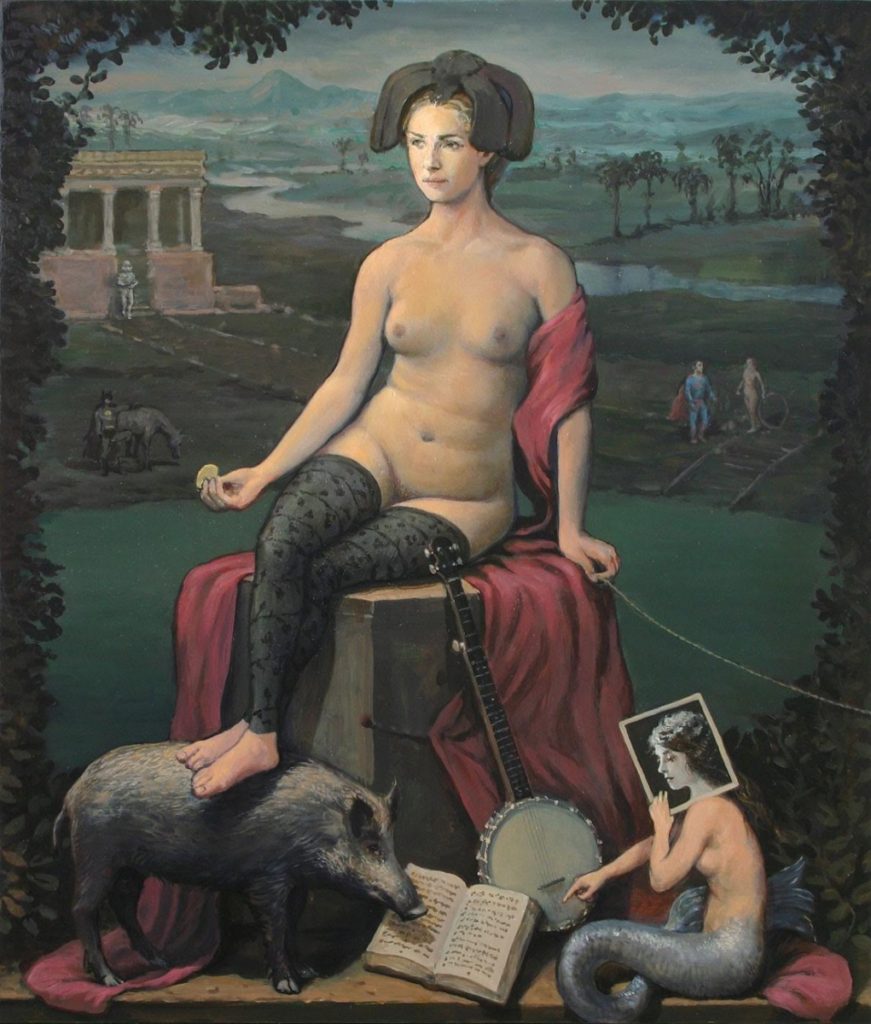
Often incorporating hyper-realistic contemporary popular culture objects and well-known phrases, Macdonald’s Renaissance style paintings are at once familiar yet strange, inviting close inspection as if asking us to solve an amusing, highly original puzzle. Alan Macdonald acknowledges that, indeed, the solution can sometimes elude him; his skill is to give us hauntingly beautiful pictorial clues which tug on our psyche while making us smile, even laugh out loud while encouraging us to search for our own answers.
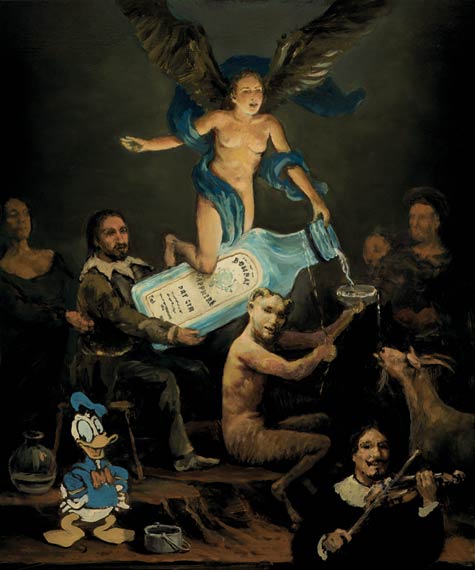
The work is archetypally Northern in its interior quality, the dark grounds and focussed illumination reminiscent of Flemish masters, the looser paint handling, particularly in the landscape backgrounds, akin to Dutch landscape and maritime painting of the 18th century. The unforgiving choice of oil on board makes the sublime delicacy of the painted surface all the more impressive.
The beguiling Bullfighters Never know When To Quit is an excellent example, a figurative group of seated male matador and classical female nude with an attendant leopard at their feet, all enigmatically focused on a scene beyond the frame. In the background three blazing buildings infuse the contemplative stillness with vitality, imminent danger and movement. This is contrasted with the delicate play of light between three aspects of self, radiant and luminous as a Titian Venus. The paint handling in this image is infused with care and vulnerability, while the presence of a line of song lyric; ”welcome back my friends to the show that never ends” provides an ironic counterfoil to the conscious theatrical staging of the composition. This humour is characteristic of the way in which Macdonald visually stages his own subterfuge, an admirable quality in work with a decidedly intellectual edge.
-Statements by Alan MacDonald © Georgina Coburn, 2011
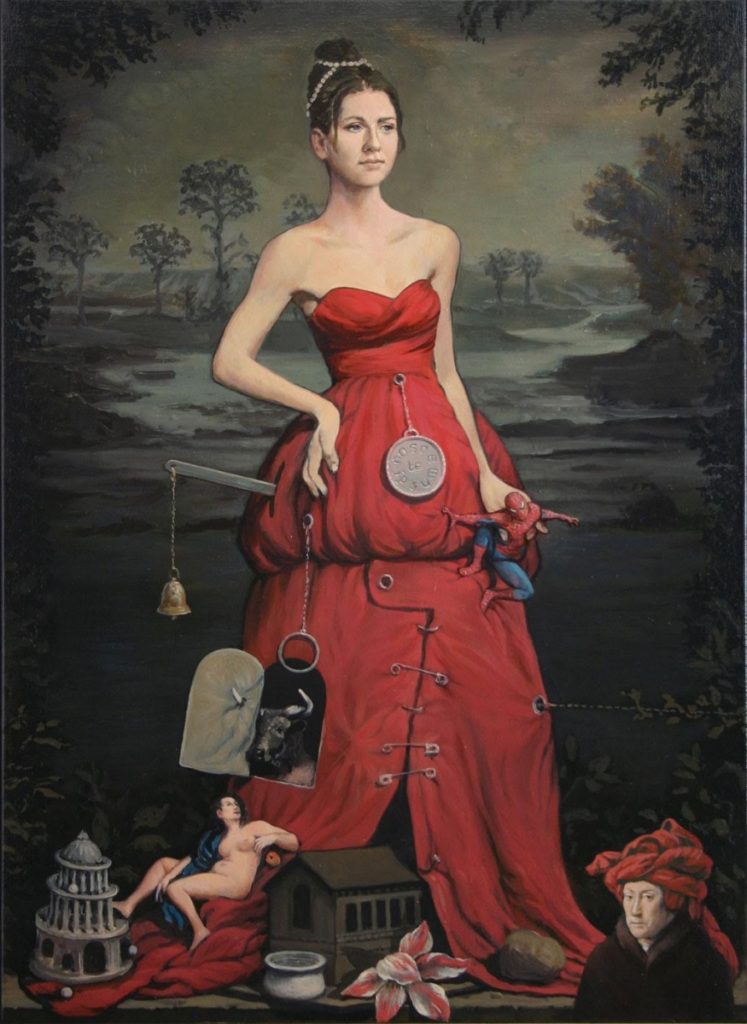
The tension in these works is compelling, and their real beauty lies in the fluid nature of association which imaginatively expands the mind of the viewer along multiple pathways of interpretation. These are works not just of a moment but of lifetimes, a real rarity in the world of contemporary art. Macdonald’s skilful and intelligent manipulation of plastic and ideological elements can be seen in the compositional strength of a large scale work, Whims of Desire.
Here a young woman stands in the tiered architecture of her black domed gown, tethered to something or someone we cannot see, a number of openings in her skirt revealing a punch spring, ball and chain, the unfurling script of a popular Joplin lyric; “lord won’t you buy me a Mercedes Benz”, a Magritte-like spoon and a bouquet of white flowers suspended from her dress. At her feet a white monkey eyes the open red “Kettle sweet chilli flavour” crisps packet in her hand while she gazes past us impassively, a smile dawning in the corner of her mouth.
-Statements by Alan MacDonald © Georgina Coburn, 2011
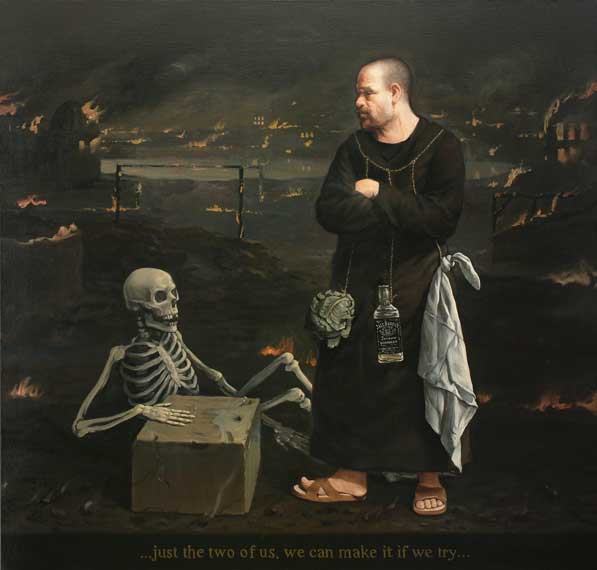
The elegance and restraint of her clothing, symbolic presence of the monkey, together with the iconography of burning buildings in the background convey psychological and sexual tension. The composition itself is a powerful pyramid structure, aligned with light, centring on her pale skin, white ribbon of script and rope tether. Within this triangle are multiple triggers for the imagination.
In Venus On Wheels a codified genre and its associative meanings are temporarily displaced by the presence of a contemporary branded object. The Classical Goddess and symbol of beauty of the title is being hauled on a cheap looking trolley, the familiar striped design of a Tesco bag a Pop prop within an image spanning multiple timeframes. The deep umber background of “dark satanic mills” heightens the illumination of the consumer object and the female nude.
-Statements by Alan MacDonald © Georgina Coburn, 2011
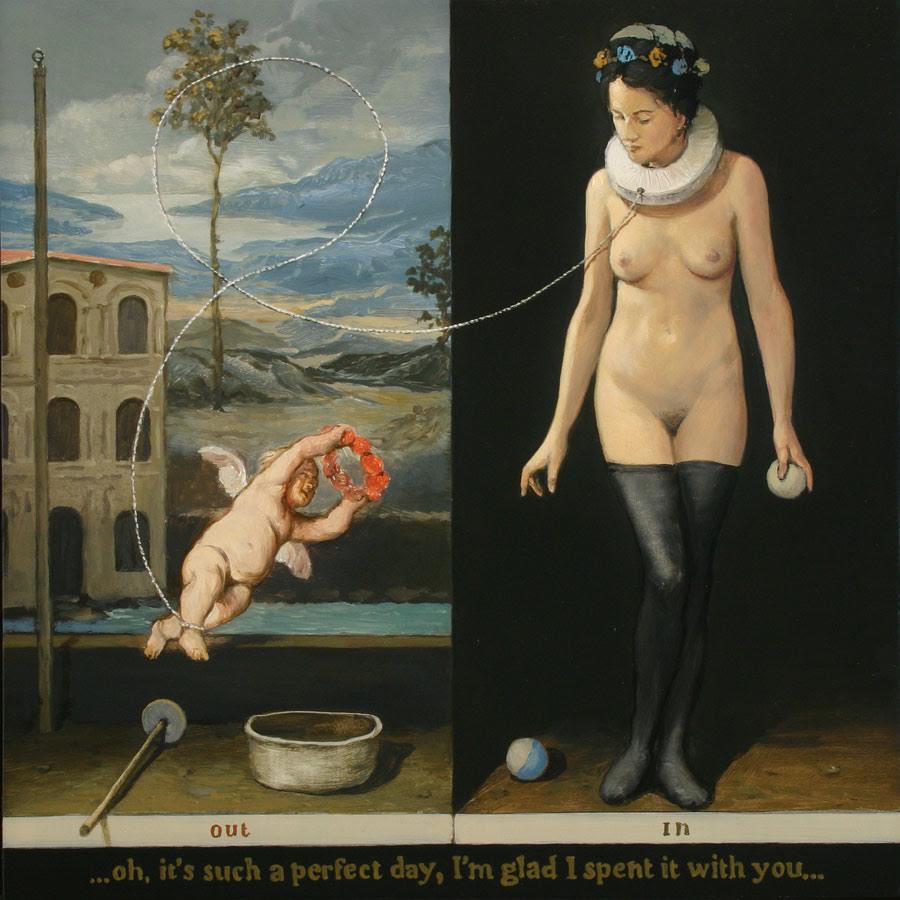
Luna is an intriguing and ambiguous image of femininity, beautifully rendered. The head and shoulders portrait is suitably enigmatic, aligned with the symbolic associations of the moon and her phases, linked with the element of water and tides. The three-quarters profile – like the trajectory of all of Macdonald‘s work – conceals and reveals. There is implied confinement in the twisted twine and safety pins which secure and tether her costume in silvery textured gossamer blue, a hue to match her eyes. Attached to one line of twine the script “fly me to the moon” introduces a Pop element /humorous Sinatra twist to what initially reads like an encoded Renaissance society portrait.
This is a fascinating show of contrasting styles, raising expectation about potential developments in Kilmorack’s regularly exhibiting artists and introducing an exciting and dynamic new artist to the gallery’s audience. It is an absolute pleasure to become lost in the multi-layered nature of Alan Macdonald’s work, encouraging repeat viewings of this extraordinary show.
-Statements by Alan MacDonald © Georgina Coburn, 2011
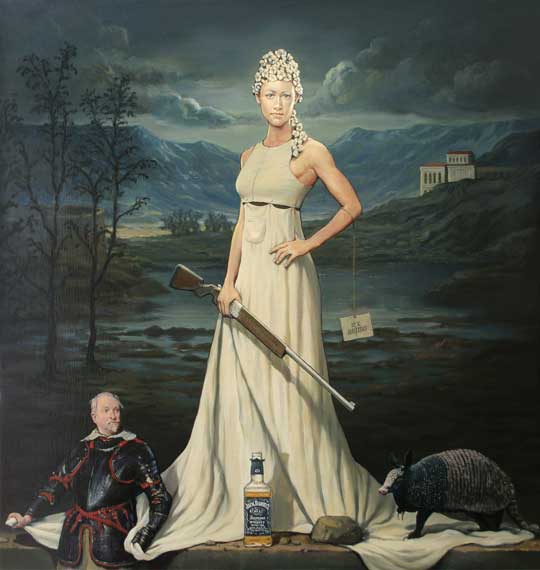
Alan Macdonald considers his work a visual journey with a subtext of a sense of adventure and excitement but destination unknown. As he tells us… “There is the belief in every painting that one day, as you set sail, you will find a faraway beach on which to land, avoiding the ragged rocks and inky depths of doubt. On one of the luckier voyages you arrive somewhere that is strangely familiar but which you have never seen before. It is a distant coast of you”.
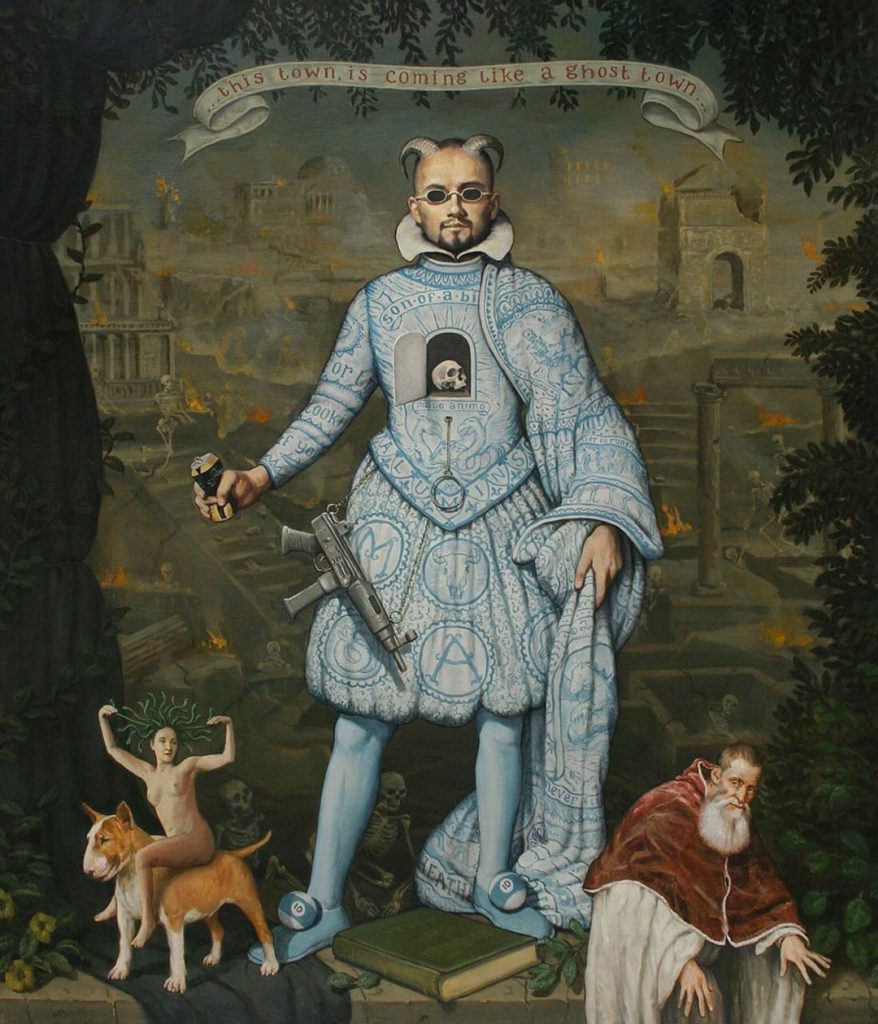
It took me years to realise that it is the darkness in things that I respond to, whether it is a painting by Francisco Goya, a song by Leonard Cohen, a play by William Shakespeare or a film by Pedro Almodovar. When I was a child living in Africa, I was outside on a night lit by the moon and, feeling a little scared, I stepped from the light into a dark shadow. The darkness wrapped itself around me and fear was replaced by an understanding that I was being protected. Later, when I was twelve, a boy walked into my classroom with drawings he had done in pencil. They were representations of figures, that went from the white of the paper to the blackest black that the graphite could muster, and from that moment the artistic light for me was ignited.
A wise old German painter friend once said to me, after seeing me floundering around trying to explain away one of my paintings, “Remember, Alan, your paintings are like a bubble, and a bubble with a hole in it is no longer a bubble.” So with that in mind, I will tread carefully.
-ALAN MACDONALD
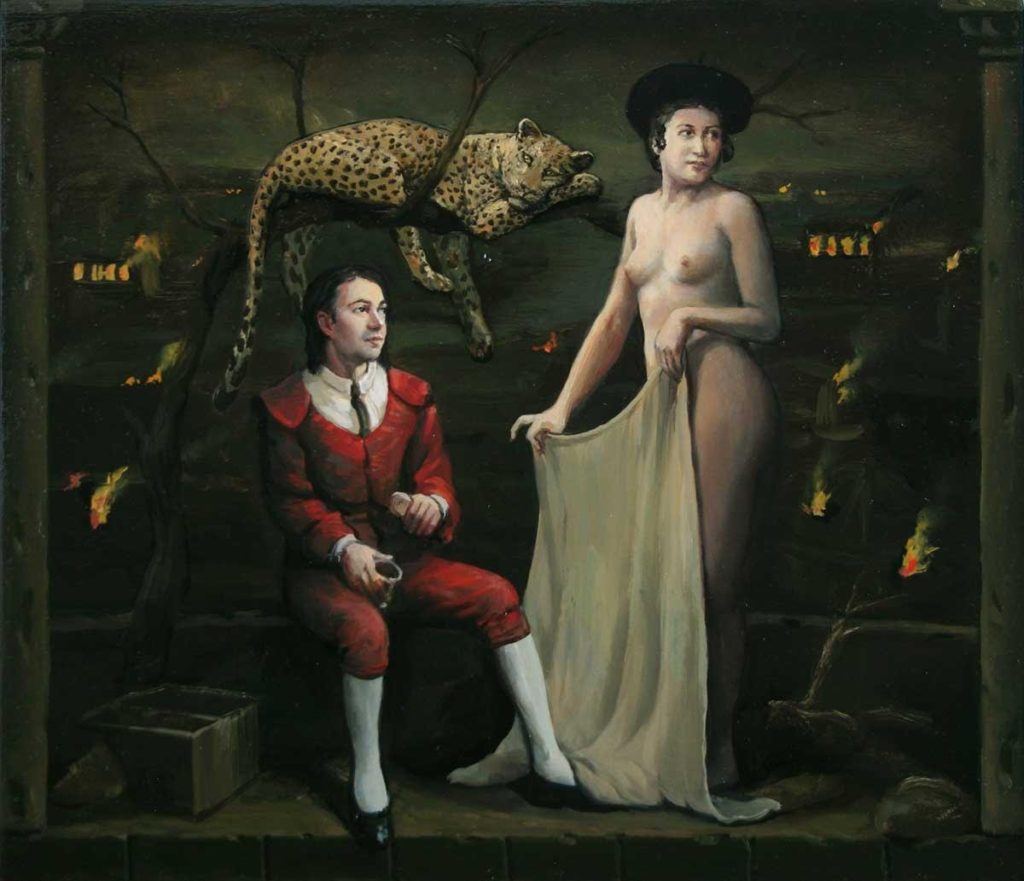
Nothing pleases me more than when someone laughs out loud whilst looking at one of my paintings. As comedians are aware, humour is a subversive thing, breaking down barriers and making others more receptive to your message or point of view. Years ago, a particularly tired, world-weary man came into my exhibition, with an, 'impress me if you can' expression on his face. He trudged from painting to painting, unimpressed… that is, until he came to a painting of a man covered in tattoos with a row of pins in his forehead, called 'Masochist'. It caused him to burst out laughing! He then went back and looked again at all the paintings he had just trudged past, now taking his time and responding to them all. It confirmed for me the importance of humour in art.
All the shapes and forms my work takes, have evolved over years. Painting clothes that resemble period clothing, for example, happened naturally. At first because it just seemed right, but I now realise that it brings to the work a sense of someone lost and out of time, desperately trying to work out the universal question, “What the hell am I doing here?” Especially when modern items like a can of coke or a scooter are included. Max Ernst once wrote that an artist should have one foot in the subconscious and one in the conscious. This, I think, is what I am trying to do.
-ALAN MACDONALD
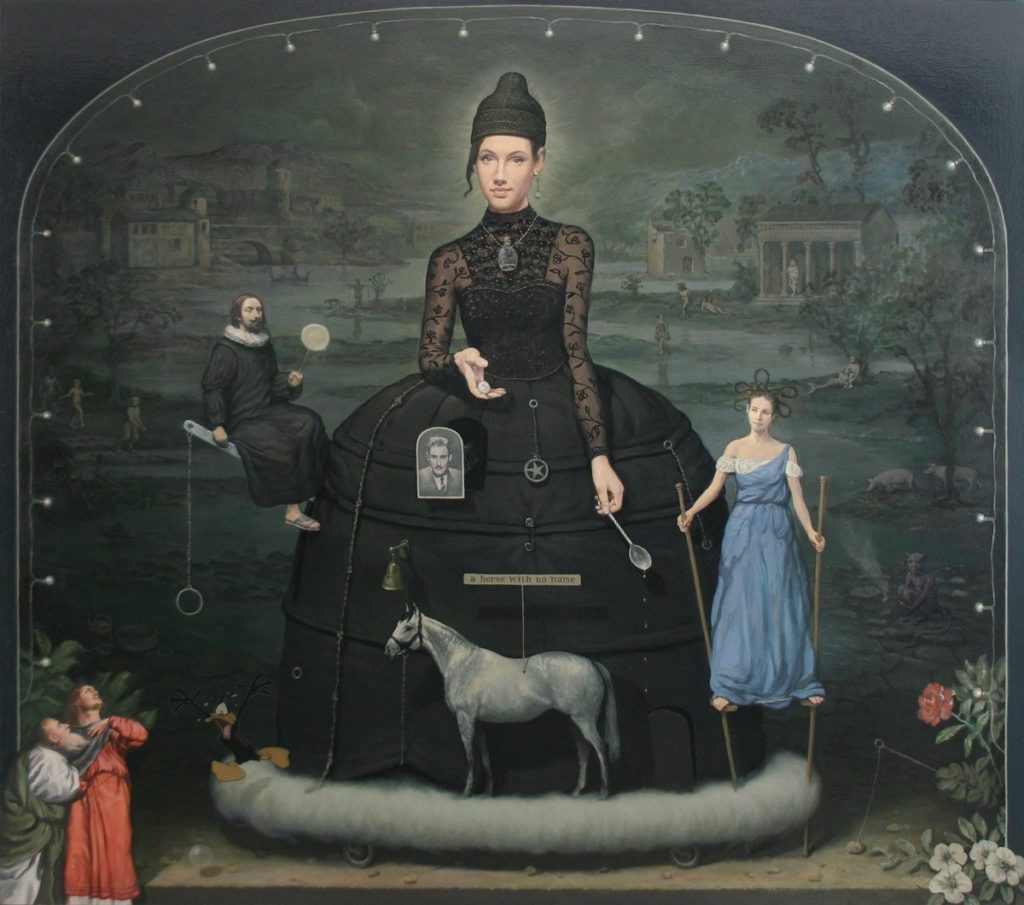
When I begin a painting, I feel like I am embarking on a journey, one in which I have no idea of the ultimate destination. As a result there is a real sense of adventure and excitement as you set sail into the unknown, armed only with a belief that, one day, you will find a faraway beach on which to land. Unfortunately, too often, the ship founders on the jagged rocks of doubt, leaving your heart to sink into the inky depths, from where you have to resurrect it. On the luckier voyages, though, you arrive somewhere that is strangely familiar, but which you have never seen before. It’s a distant coast of you.
-ALAN MACDONALD
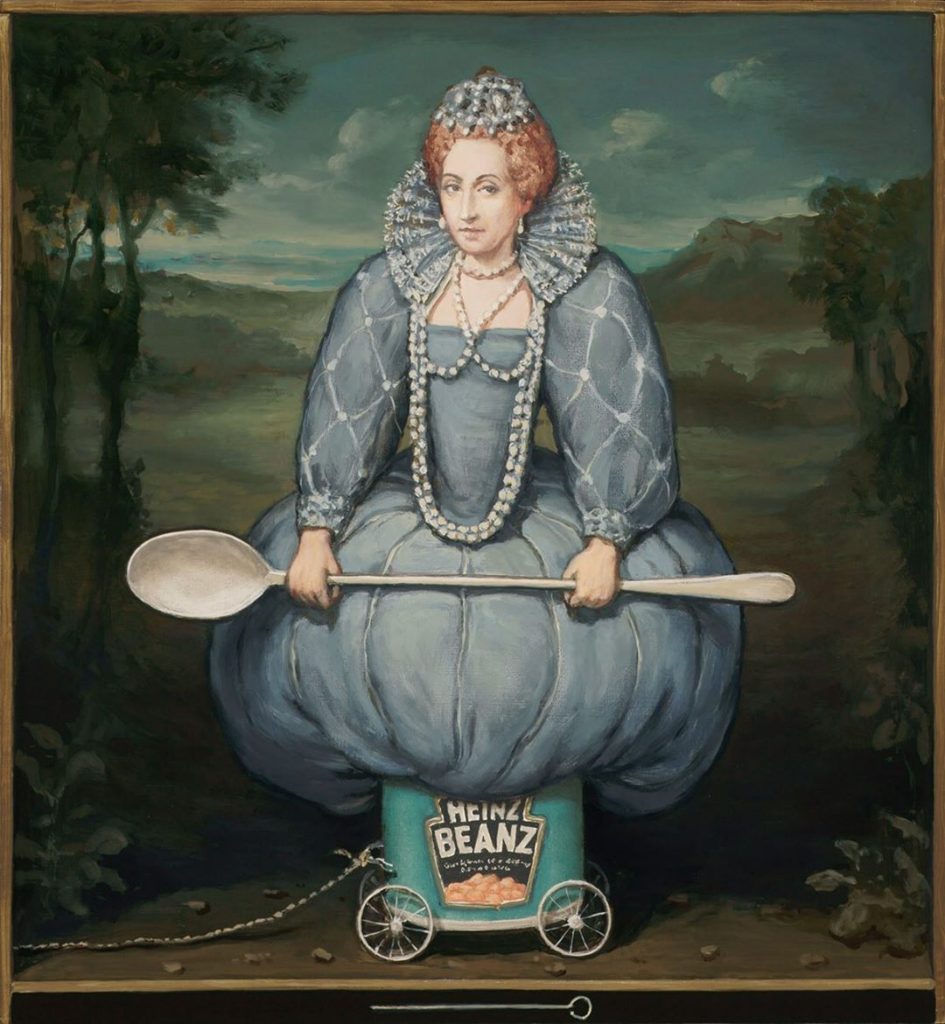
Alan MacDonald is a brilliant artist, and I would be proud to hang his art within my home.
Movies that Inspired Me
Here are some movies that I consider noteworthy and worth a view. Enjoy.




Stories that Inspired Me
Here are reprints in full text of stories that inspired me, but that are nearly impossible to find in China. I place them here as sort of a personal library that I can use for inspiration. The reader is welcome to come and enjoy a read or two as well.









































My Poetry

Art that Moves Me





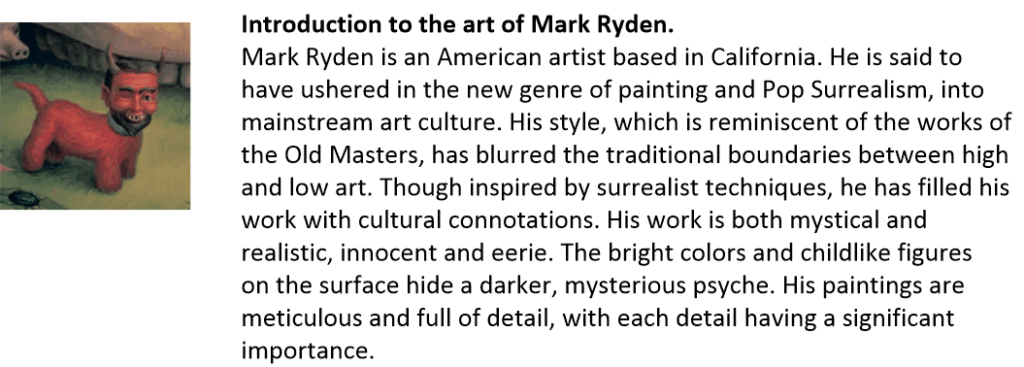
Articles & Links
You’ll not find any big banners or popups here talking about cookies and privacy notices. There are no ads on this site (aside from the hosting ads – a necessary evil). Functionally and fundamentally, I just don’t make money off of this blog. It is NOT monetized. Finally, I don’t track you because I just don’t care to.
- You can start reading the articles by going HERE.
- You can visit the Index Page HERE to explore by article subject.
- You can also ask the author some questions. You can go HERE to find out how to go about this.
- You can find out more about the author HERE.
- If you have concerns or complaints, you can go HERE.
- If you want to make a donation, you can go HERE.

